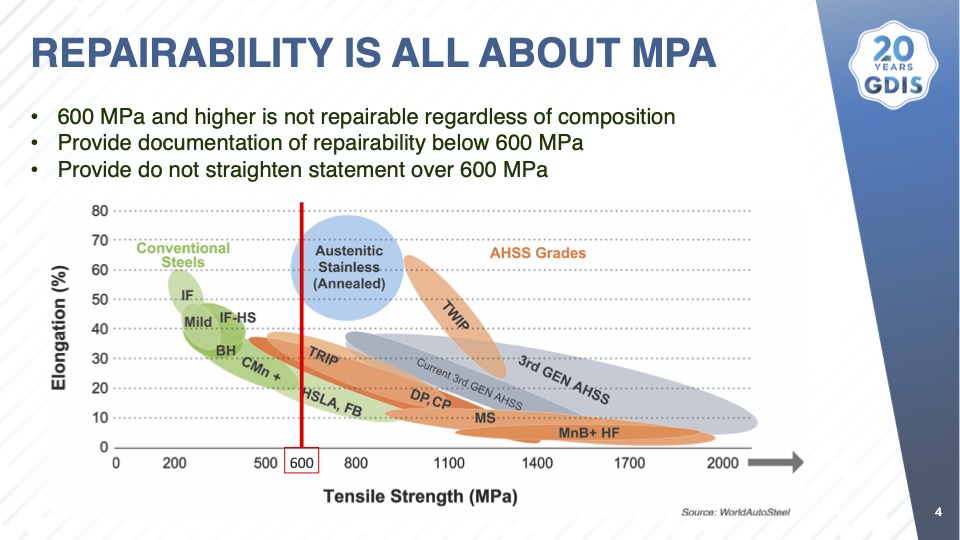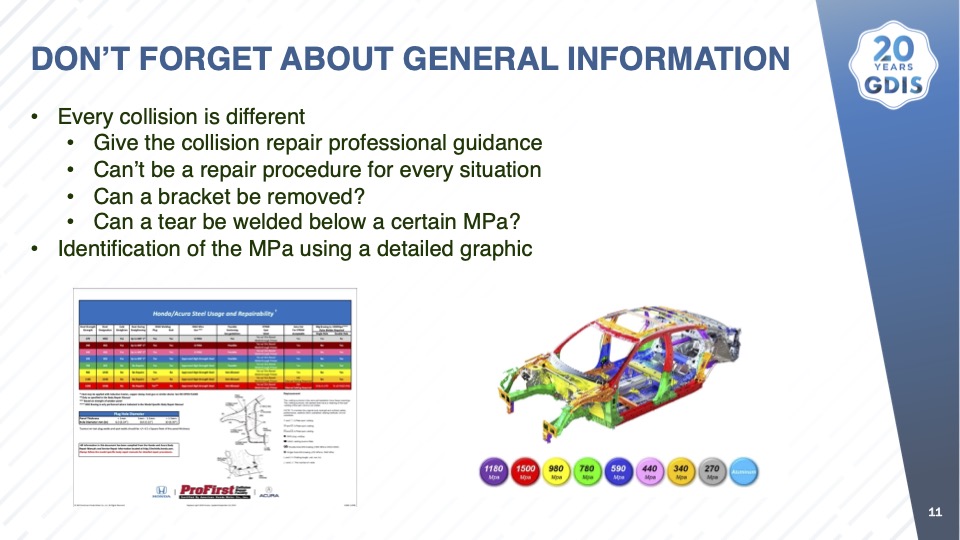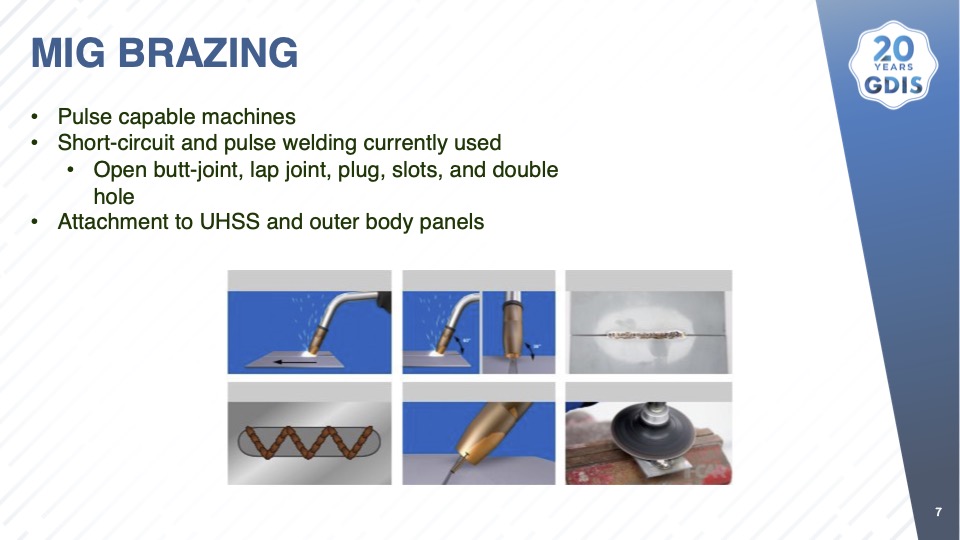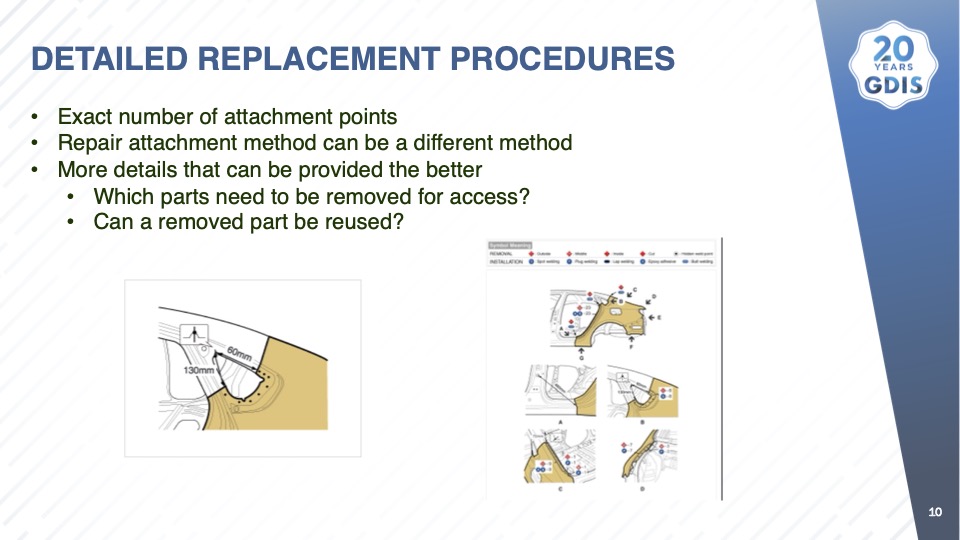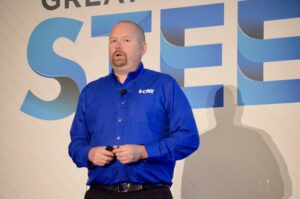
I-CAR manager encourages OEMs to keep the needs of repairers in mind
By onAnnouncements | Collision Repair | Repair Operations | Technology
With vehicle construction methods and materials growing more complex, collision professionals need the help of OEMs more than ever in understanding how to carry out safe and proper repairs, Scott VanHulle, manager of repairability technical support (RTS) and OEM relations for I-CAR, told an audience at the Great Designs in Steel (GDIS) automotive materials conference on May 18.
“I want to encourage everybody here to think about the replacement methods for the collision side of the industry,” VanHulle said. With assembly lines using joining techniques that are not duplicated in collision repair, “How it’s manufactured is not how we are putting these vehicles back together.”
One example, he said, is shops’ limited ability to duplicate factory spot welds, because of the length of the arms of spot welders used in body shops. Showing a photo of a spot welder, he noted, “that’s all the depth that we have. So it’s deeper than that for the reach of that spot welder, it’s not going to be possible in a collision repair facility.”
Laser brazing, as Honda uses to attach the roof of the 2022 Civic and other models, is another example. “We need a very, very detailed procedure on that because we cannot recreate laser bracing or laser welds in the body shop. There are no tools available that we could safely use in a repair facility in that case,” VanHulle said.
The automotive industry is increasingly focusing on advanced high strength steel (AHSS), to save weight while maintaining a vehicle’s strength. But while the industry uses various names to refer to the materials, repairers are primarily interested in one characteristic: the steel’s tensile strength, rated in mega Pascals (MPa).
“For the collision repair industry, once we get to the 600 MPa range, the repairability of that steel becomes pretty much unimportant,” he said. Because steel above 600 MPa is more likely to crack when straightened, “we’re basically going to be cutting a part off and replacing it,” he said.
That means that it’s crucial for repairers to know what kinds of steel are used in each area of a vehicle’s body in white. “There are a lot of times when we start talking about TWIP [Twinning-Induced Plasticity steel] and Martensitic and boron and dual phase metal,” he said. “When it comes to straightening in the collision world, that really doesn’t have any bearing … it really boils down to that strength rating of 600 MPa and can it be strengthened or not. So the more clarity we can have on that, the better.”
He said OEM body in white graphics, such as the ones shown in presentations at GDIS, “are also a huge tool that we can use on the collision side of the industry, because it helps us make those repair and replace decisions. We instantly know that okay, this part says 1,500 MPa. If it’s got a ding on it, I have to replace that part.”
Just making the correct repair information available to technicians can be a challenge, VanHulle said. He encouraged OEMs to develop ways of better sharing that information, “so we’re not guessing on what we actually need to do.”
He suggested the use of QR codes on parts that would connect technicians with correct repair procedures, or a vehicle graphic that would allow a repairer to click on a specific area to access that information. A graphic would be especially helpful, he said, because OEMs often use different names for similar parts.
Some OEMs are now requiring manual welder settings for specific panel stacks. “Having that detail and having it prevalent in the repair information is extremely critical because if it’s buried in another document or somewhere else hidden, it’s very difficult for us to find that … in the main, plug welding is typically going to be done wherever those spot welding arms can’t reach.”
Many shops have the equipment and expertise to carry out MIG brazing and are looking for sectioning locations on quarter panels and other panels, particularly in areas overlaying ultra high strength steel. “There’s a lot less heat involved with [MIG brazing]. So it helps kind of mitigate that fear that we’re destroying some of that ultra high strength steel that might be underneath,” he said.
General repair information “is extremely important … because there’s no way that any manufacturer can ever come up with every repair situation,” VanHulle said. For example, knowing whether a single bracket could be removed from a panel and replaced could simplify repairs. “The tearing of a floor is a good example,” he added. “Can we straighten that, weld that? Some guidelines around that are always extremely helpful.”
Collision repairers have a wide array of techniques that they can use, and just need direction from the OEMs, he said. “If there’s areas where there’s no access, we can put adhesives in. We can do rivet bonding. The industry has the tools and techniques to do that. We just need to be told where to do all of these different techniques, all the different fasteners, and the combination of all the attachment methods,” he said.
“As we get more ultra high strength steel and composites and everything else all lumped into this one vehicle, all to keep that passenger safe, we need these alternative methods to really save more vehicles so they’re not being total losses.
“We’ve talked about reducing our carbon footprint. …The more of these cars that get totaled out, the more cars that need to be built. So it’s also in the best interest of the world to have these vehicles be more repairable,” VanHulle said.
He noted that repairers need information from the OEMs before a vehicle hits the dealer’s lot. “The new Ford Lightning that just came out, there was already one at a body shop last week,” VanHulle said. “The very first day that vehicle hits the road, some shop has to deal with it. And so we need that information out front, not after the vehicle’s been out for six months or a year.”
VanHulle underscored the importance of access to proper repair procedures by telling the story of Matthew and Marcia Seebachan, who were badly hurt when their 2010 Honda Fit was struck by another vehicle. Unbeknownst to them, John Eagle Collision Center had attached the Fit’s roof with adhesive during a 2012 hail repair for the vehicle’s prior owner, despite the fact that Honda repair procedures called for more than 100 spot welds.
“They did not follow that factory procedure, and that was the end result,” he said.
“We need that information because we want to make sure that that vehicle performs the same way in the second collision as it did in the first one.”
Images
Scott VanHulle, manager of RTS & OEM relations for I-CAR, addresses an audience at the Great Designs in Steel automotive materials conference in Novi, Michigan, on May 18. (Dave LaChance/Repairer Driven News)
Graphics provided by I-CAR

